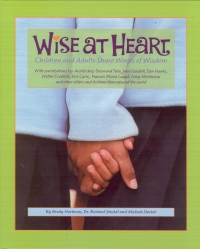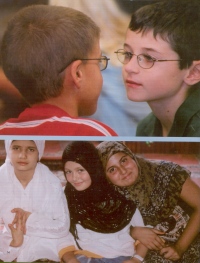| ________________
CM . . . . Volume XVII Number 34 . . . . May 6, 2011
excerpt:
Wise at Heart is like a chocolate Easter bunny:: glossy, sweet, and prettily packaged, yet hollow at its centre. That is, the book's message is best solidified through the dialogue and interactions it means to evoke. Through the photographs and words of wisdom they've collected, the authors wish to instill in young people compassion for self and others. Moreover, they encourage parents, grandparents, caregivers, community elders, and teachers to use Wise at Heart as a "springboard" or "touchstone" with children "by reading a page a day - discussing, reflecting and sharing" (p. 68). Apart from a two-page introduction entitled "On a Journey for Wisdom," and eight pages of back matter, the bulk of the book's content is organized into three categories: "Wise Inside," "Peace Wise," and "Nature Wise." The sections become successively shorter, at 26, 20, and 12 pages, respectively, as they share insights about the individual in relationship to self, to society (and potential conflicts with others), and to nature. Whether deliberate or accidental, the book's layout creates tension between words and images. Compelling photographs of precious children, representing the diversity of 18 countries, compete for readers' attention with quotations from the likes of Desmond Tutu, Tom Hanks, Jane Goodall, Walter Cronkite, and others. On the smooth, glossy pages, both generously-proportioned images and large print text stand out against delicate backgrounds in light green, coral, lilac, blue, goldenrod, and other pastel shades appropriate for a spring release. Decorative strands of tiny hearts, in a lighter value of the background hue, frequently trail along a page's edge. Wise at Heart's visibility and legibility come with a tradeoff, however: at 27 cm tall x 21 cm wide, its size decreases the ease of its portability. Given its purpose to promote interaction and interconnectivity, it's more likely to be found on a nightstand, coffee table, or shelf in a classroom or library than in a backpack, anyway. As the authors remind their readers, no one human being or group of human beings has a monopoly on wisdom. Accordingly, the book aims for a balance of quotations between adults and children, and achieves it in its nearly half-and-half mixture (32 from adults, 28 from children). The child contributors range in age from 5 to 17, with slightly over one-third of quotations originating with 10 and 11-year-olds. Furthermore, the book contains quotations from twenty - and thirty - somethings Brittany Bergquist and Craig and Marc Kielburger who, as adolescents, founded organizations that have had wide-ranging impact. Another special detail deserving mention is the placement of quotations by a father and daughter, Greg Mortenson and Amira Mortenson, 13, on facing pages. (p. 42-43). Although individuals of any age may enjoy Wise at Heart, one imagines it would leave its greatest impact on children 7 to 11 who will relate to the pictures of children close to them in age. Despite all its exemplariness, the book has a few soft spots. For instance, the authors recount in the introduction how "a yearlong journey" yielded "wisdom insights from almost three hundred elders around the globe and nearly as many children" (p. 4), yet they do not identify the criteria they used in narrowing down quotations to the book's final sixty. A bit further on, they attempt to define "wisdom" in eight bullet points - seven too many, given four vague statements and three figures of speech (two similes, one antimetabole) that do little to advance a solid definition. The second-to-last assertion, that "Wisdom usually points to universal truths found in many traditions and cultures around the world" (p. 5), could have sufficed. While the feel-good flavor of those universal truths is undeniable, they do leave behind an aftertaste of cliche. The predominant wisdoms are variations on the themes "you are special; be yourself," "believe in yourself," and "be kind to all." Consequently, a contribution such as Sandra Boynton's refreshingly pithy "Notice stuff!" (p. 56), or Jolie Runyan Finkbiner's reflection on Edwin Markham's poem, "The Circle" (p. 40), are a welcome change of fare. Finally, although Wise at Heart was published simultaneously in Canada and the USA, since Kids Can Press acknowledges funding from the Government of Ontario, readers might have expected more Canadian content. True, four adult contributors are Canadians - the Kielburger brothers, Mary Gordon, Joe MacInnis - but only one of the 77 photos represents Canada, in contrast to the 25 taken in the USA. All things considered, if one is going to indulge in this compilation, perhaps it is best to do so not all in one sitting, but as the authors recommend, little by little, reading a page a day. For more on the project that gave rise to the book, visit: www.milestonesproject.com. Recommended. Julie Chychota is a transplanted Manitoban who coordinates computer interpretation services for d/Deaf and hard of hearing students at the University of Ottawa. Copyright © the Manitoba Library Association. Reproduction for personal
use is permitted only if this copyright notice is maintained. Any
other reproduction is prohibited without permission.
NEXT REVIEW |
TABLE OF CONTENTS FOR THIS ISSUE
- May 6, 2011.
AUTHORS |
TITLES |
MEDIA REVIEWS |
PROFILES |
BACK ISSUES |
SEARCH |
CMARCHIVE |
HOME |

 The wisdom-dispensing portion of the book ends with three quotations collected under the heading of "Some Wise Good-byes." In "A Few Ways to Use Wise at Heart," which follows, the authors suggest activities that adults may complete with, or for children, to further pass along wisdom. Three final pages contain brief biographical entries for each of the 33 "Adult Contributors" - mostly authors, artists (illustrators), advocates, and activists, along with an actor, an archbishop, and an anchor for good measure.
The wisdom-dispensing portion of the book ends with three quotations collected under the heading of "Some Wise Good-byes." In "A Few Ways to Use Wise at Heart," which follows, the authors suggest activities that adults may complete with, or for children, to further pass along wisdom. Three final pages contain brief biographical entries for each of the 33 "Adult Contributors" - mostly authors, artists (illustrators), advocates, and activists, along with an actor, an archbishop, and an anchor for good measure.